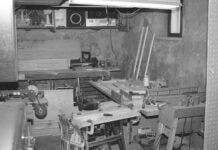
Transfer screws and pins are available in popular diameters for rivet and screw holes. Shown here left to right: 10-32, 3/16-, 5/32-, and 1/8-inch.
In a previous “Plane and Simple” column [“Locate That Hole Precisely,” April 2017], we discussed one popular method for locating holes in metal components using a strap duplicator. This tool was indispensable for helping create a replacement part that needed precisely located holes drilled. The principle involved a strap with a bushing that guided our drill precisely over a location where we could not see the hole in the part below. One of the limitations of this tool is the length of the strap. This length limits the distance a hole can be located from the nearest edge of that part. A metal sheet, for example, longer and wider than about 10 inches, cannot use a typical strap duplicator tool. Also, for each hole to be “duplicated,” the strap duplicator tool needs repetitive use at each hole location to finish the job.

This inspection opening has six of the eight nutplate holes filled with transfer screws and is ready for its new cover to be marked for new holes.
An alternate method for locating holes makes use of small machined metal tools called center locating punches. These are designed for duplicating either threaded or unthreaded holes. They are known by a number of names that include: blind hole spotter, transfer pin, transfer screw, or hole locating transfer punch. They are sized for the diameter of the hole you need duplicated. One end of the tool has a sharp point located in the center. The other end has either a threaded or smooth shank. The threaded-shank version is used for threaded holes, and it simply screws into an existing nutplate or thread. The smooth-shank version is meant to be placed into a non-threaded rivet hole. If you have 10 holes that need duplication, then 10 of these transfer pins can be used at one time for a really fast operation!

A gentle blow of the hammer will leave a small, clear mark indicating where the new holes are to be drilled for a perfect fit.
An example of using these transfer pins is shown in the pictures. In this example, an inspection cover plate was lost or misplaced on the tail of this aircraft. Creating a new round cover out of aluminum sheet is easy but it is very important that all eight holes be drilled precisely to match the underlying nutplates located on the fuselage. A strap duplicator could be used for this purpose but it would have to be used eight times to complete the job. (Length of the strap is not an issue in this case.) We’ll use threaded transfer screws for this job. The nutplates for this cover use size 10-32 screws, so we need a set of 10-32 transfer screws. Simply screwing them into each nutplate is the first step. (Note in the picture we only had six available of the eight required; we need to repeat the process one more time for the last two). The next step is to position and hold our new cover plate stock over the location and gently rap the cover with a soft hammer. This creates a small but definite imprint of the exact location of each nutplate hole. The last step is to place the cover on the workbench and carefully drill each hole on top of the tiny imprints left by the transfer screws. The process is identical for unthreaded rivet holes except we use the unthreaded transfer pins that are sized for that hole. Gravity or a dab of grease holds these pins in place for the duration of the transfer operation.
Inexpensive, simple, and fast to use. They are available from some aviation tool suppliers and industrial supply companies like McMaster-Carr. If you have a challenge finding these tools when searching online, remember they are known by the various names mentioned previously.

![]()
As the founder of HomebuiltHELP.com, Jon Croke has produced instructional videos for Experimental aircraft builders for over 10 years. He has built (and helped others build) over a dozen kit aircraft of all makes and models. Jon is a private pilot and currently owns and flies a Zenith Cruzer.














I enjoy and learn a lot from your tips, John. Very well written and illustrated. Concise and to the point. Thanks for all your videos and articles!